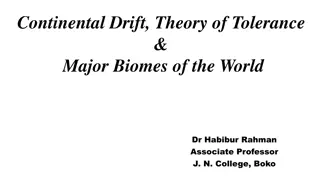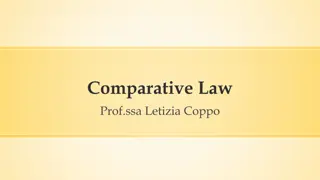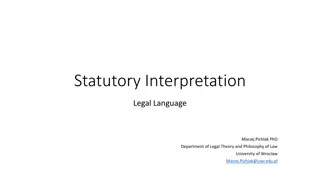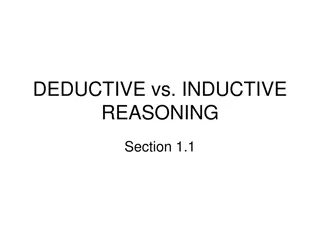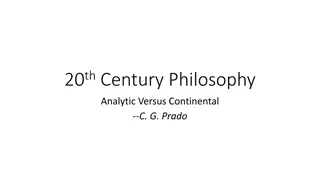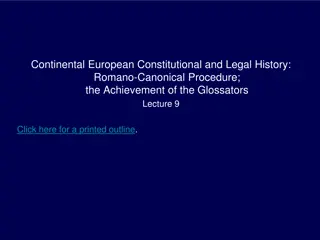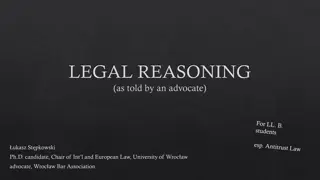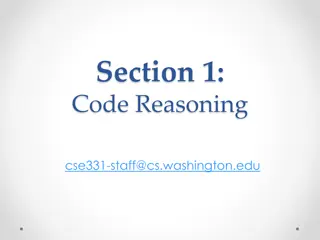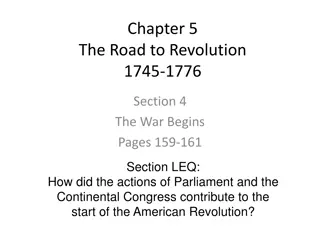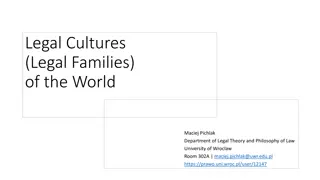Contrasting Legal Reasoning in Common Law and Continental Law Systems
This inaugural lecture explores the differences in legal reasoning between judges on both sides of the English Channel. It delves into the declaratory theory of decision-making in Common Law and the application of legislative intent in Continental Law. The lecture also touches on the contrasting inductive and deductive reasoning methods employed in each legal system, highlighting the tension between comparative law writings and legal theory publications regarding the universality of legal reasoning. Despite differing cultural backgrounds, a shared rationality is believed to underpin intercultural understanding.
Download Presentation

Please find below an Image/Link to download the presentation.
The content on the website is provided AS IS for your information and personal use only. It may not be sold, licensed, or shared on other websites without obtaining consent from the author.If you encounter any issues during the download, it is possible that the publisher has removed the file from their server.
You are allowed to download the files provided on this website for personal or commercial use, subject to the condition that they are used lawfully. All files are the property of their respective owners.
The content on the website is provided AS IS for your information and personal use only. It may not be sold, licensed, or shared on other websites without obtaining consent from the author.
E N D
Presentation Transcript
Do Judges Reason Differently on Both Sides of the Channel? Inaugural lecture at Queen Mary University of London Mark Van Hoecke Professor of Comparative Law 3 September 2018
1. 1. Mystification Mystification Keeping up appearances of continuity when changing the law: Where the law is changed by a judicial decision, the traditional working assumption upon which the common law proceeds is the declaratory theory of decision-making: the judges declare law but do not make it and the law is regarded as having always been what the judicial decision stated it to be. (Jack Beatson, Camb.LJ 1997) On the Continent judicial changes have mostly been presented as an application of the intention of the legislator.
Inductive v Deductive Reasoning The continental lawyer, it is said, uses purely deductive reasoning while the Common Law employs inductive reasoning
Comparative Law v Legal Theory An incommensurability of the ways of legal reasoning in different legal cultures is typical in comparative law writings. In legal theory publications the image is the opposite: legal reasoning is always treated as universal. Although some views may partly be linked to local traditions, they all take part in one and the same discussion on legal reasoning, which is implicitly assumed to be common to all mankind, at least within the Western world. Anthropology even accepts that there is some common rationality, shared by all human cultures, which makes intercultural understanding possible
In early anthropology the primitive man was looked at as unable to indulge abstract reasoning and that his entire thinking is pre-logical and mystical. From a continental point of view the English Common Law may be looked at in a similar way: no abstract reasoning, no strict logic and mystical assumptions, such as judges not creating law but only finding the law as it has been there since times immemorial . However, a similar rationality is present on both sides of the Channel, be it that some English and continental lawyers have tried to keep up the image of quite diverging rationalities
2. 2. Deductive Deductive v v Inductive 2.1 Common Law 2.1 Common Law Reasoning Inductive Reasoning Reasoning Reasoning In the Common Law, reasoning is said to be inductive: from the facts to the law. Judicial decisions are considered to be based on the facts of the case rather than on pre-existing rules or principles. The history of the Common Law shows that it was in essence a system of adjudication, which drew its substantive notions from below through cases presented to courts. (Michael Lobban 1991)
Common Law Common Law Reasoning Reasoning Only precedents are binding. By the technique of distinguishing even slightly different cases can be considered not to fall under a binding precedent . As the facts of different cases are never completely identical, in all aspects, the common law permits much flexibility with regard to the judge
Common Law Common Law Reasoning Reasoning Common Law thinking is also practical: there is an absence of abstract reasoning. In the common law, it is argued, the decision arises from the facts, not from rules . However, facts do not lead to any normative conclusion, unless they are combined with rules. It is true that common law judges often present their decision in this way, but this simply means that the applied rules and principles are hidden, not that they are absent.
Common Law Reasoning: White v Jones In White v Jones, the House of Lords decided that a solicitor is liable for the loss of a legacy towards the daughters of his client, because he did not draw up a new will in time, after his client had asked him to do so. It is not the sheer facts of the case which offered this result. If the solicitor has done nothing during six weeks, this can only be considered to be a negligent behaviour if one assumes a rule, according to which the solicitor should have drafted a new will earlier. As stated by Lord Goff in this case: As a general rule ... there is no liability in tortious negligence for an omission, unless the defendant is under some pre-existing duty. Once this negligence is concluded, the question arises whether the solicitor is liable towards the daughters of his client. The Law Lords turn again from the facts to the rules: (1) the general rule that a solicitor acting on behalf of a client owes a duty of care only to his client , (2) a plaintiff is entitled to damages if, and only if, he can establish a breach of contract by the defendant , (3) as a general rule, apart from .., no action will lie in respect of purely financial loss in the tort of negligence .
Common Law Reasoning: White v Jones However if these rules were to be applied to the facts, the action should have been dismissed, the two daughters receiving nothing. But the judges looked for another rule, a rule of justice, which says that it would be unjust to dismiss the daughters action. Starting from this moral rule the legal rules were being reinterpreted with the result that the judges concluded that there was, surprisingly, a lacuna in the law that "needs to be filled (again a rule). And this was achieved by holding that the assumption of responsibility by the solicitors towards his client should be held in law to extend to the intended beneficiary who (as the solicitor can reasonably foresee) may, as a result of the solicitor s negligence, be deprived of his intended legacy in circumstances in which neither the testator nor his estate will have a remedy against the solicitor. Here, a rule is construed by the House of Lords, for filling of a construed gap. This example shows clearly how the reasoning is moving constantly from facts to rules and vice versa, and even from established legal rules to moral values and rules of justice.
Common Law Reasoning: statutes As statutory law has been increasing considerably in the UK in the course of the last few decades , deductive reasoning, comparable to what may be found on the Continent, is also present here. On the Continent there is a strong presumption of coherence and completeness of legislation, which is much less present in the Common Law. This may affect the interpretation of statutes to some extent, but in terms of inductive and deductive reasoning the situation should be comparable, when it comes to applying legislation.
Common Law Reasoning: Coherence The common law frame of mind assumes that although law may appear to be irrational, chaotic and particularistic, if one digs deep enough and knows what one is looking for, then it will soon become evident that law is an internally coherent and unified body of rules. This coherence and unity stems from the fact that law is grounded in, and logically derived from, a handful of general principles. (David Sugarman 1986)
2.2 2.2 Continental Continental Reasoning Reasoning The continental lawyer, on the other hand, is presumed to reason from provisions in a Code which he applies to facts. Facts are presumed to come into play only at the end of the legal reasoning, when the applicable rules are deductively applied to the facts. In practice, however, the facts often play an important role, both in the choice and in the interpretation of the rules which will be considered to apply to them . It has even been argued, by prominent legal scholars, that judges on the Continent reason more inductively than deductively
Continental Reasoning: Some Cases A. Male A. Male Adultery Adultery An example of changing the law through a broad interpretation can be found in the Belgian case law as to male adultery. The Code Napoleon, which remained valid in Belgium after its independence in 1830, distinguished between male and female adultery as a reason for divorce. If a wife had committed one act of adultery, this sufficed both for the man to ask for divorce and for the wife to be guilty of a crime (art.389 Belgian Penal Code between 1867 and 1974). However this situation did not apply to the male adulterer. It was considered to be acceptable for a married man to have one (or more) lovers and even renting a flat for them, where the man could meet his mistress, and maintaining them did not raise any objection. Nevertheless it would be a step too far for the married man to keep and maintain his lover in his home, under the nose of his wife. Hence, in such cases, the wife could ask for a divorce (art.230 Cc) and the man could be punished by a criminal court (art.389 Belgian Penal Code until 1974).
Male Adultery As for suing in divorce, it sufficed for a man to prove one single adultery act on behalf of his wife, but the wife, in order to obtain a divorce, had to prove that her husband was maintaining his concubine in the home of the spouses . This provision did not change in Belgium until 1974. Yet, from the middle of 19th century, judges interpreted the article of the Civil code in such a way that divorce could be obtained almost as easily by women as men. Only the concept of concubine left some difference. One act of sexual intercourse was not enough to make a women one s concubine , but several (a few) did suffice for the judges. Maintaining seems to imply a substantial financial effort by the man, but for courts just giving a gift sufficed for considering a man to maintain his girlfriend. Moreover maintaining one s girlfriend in the home of the spouses did not prevent judges from applying it to whatever place where the husband met his girlfriend, including a second residence, a hotel room , a tent, a caravan , a flat owned or rented by the woman , etc. As the wife is entitled to follow her husband wherever he goes, the courts reasoned, any place where the man finds himself should be considered at that time to be the home of the spouses .
Male Adultery So, through a very broad interpretation which obviously conflicted with the intention of the authors of the Code Napoleon, judges adapted this provision in accordance with changed views on moral duties of spouses and equal treatment of husband and wife. The Belgian legislator never reacted to this jurisprudence of the courts. Precisely because judges had almost completely emptied that discrimination between husbands and wives there was no pressing need to change the Code on this point. Finally, the legislator abolished the different treatment of men and women as late as in 1974. Today, sexual intercourse outside marriage is no longer a reason for divorce; it suffices to obtain a divorce that one of the spouses no longer wishes to live with the other one, whatever the reasons for that may be.
Continental Reasoning: Cases B. B. Abuse Abuse of of Rights Rights The French Civil code of 1804 defined property as the right to use, to enjoy and to take profit of one s property in the most absolute way . (Art. 544). In one case, which has been decided in 1855, the owner of a house built an enormous fake chimney just to annoy his neighbour (with its shadow) and without it being of any other use for the owner. The court of Colmar ought in principle to have accepted this on the basis of the very broad wording of property rights in the code. Nevertheless, the court considered the building of this chimney an abuse of his property rights and, hence, ordered the pulling down of that fake chimney .
Abuse of Rights One year later the Lyon Court of appeal decided in the same way against someone who had blocked up a water source on his land which took away the water from neighbouring sources but which was of no use to the landowner who simply let the water flow into a river. Subsequently, the prohibition of abuse of rights was extended to cases where the proprietor had a genuine interest in what he did, but where he could have acted in another way that would have caused less damage to others. As from mid-twentieth century it has been accepted by courts as an unwritten general principle of law applying to all fields of the law and in some cases explicitly worded in legislation.
Abuse of Rights These cases are excellent examples of facts creating law . When, deductively, a strict application of legislative rules leads to an undesirable result (on moral grounds) an inductive reasoning leads from the facts and the moral rules to new legal rules. A typically Common Law reasoning on the Continent. This doesn t mean that the Common Law would accept a concept like abuse of right . Rather not: if it is a lawful act one has the right to do it, however ill the motive might be . However, a similar result may be achieved through the concept of unreasonable behaviour .
Abuse of Rights & Common Law In the case Ruxley Electronics v Forsyth a swimming pool had been built six foot nine inches deep, whereas according to the contract it had to be seven foot six inches. The Court of Appeal decided that a new swimming pool had to be built in conformity to the contract. The House of Lords, however, following the trial judge just awarded a modest financial compensation ( 2,500), on the basis of the following reasoning: the respondent has acquired a perfectly serviceable swimming pool, albeit one lacking the specified depth. His loss is thus not the lack of a useable pool with consequent need to construct a new one. Indeed were he to receive the cost of building a new one and retain the existing one he would have recovered not compensation for loss but a very substantial gratuitous benefit, something which damages are not intended to provide.
Abuse of Rights: Continental v Common Law On the Continent the reasoning in such a case would have been that the size of the damage is disproportionate compared to the cost of building a new swimming pool. Hence, the claim for a new pool would be considered an abuse of right and the claimant should be happy with more limited damages, compensating his loss. The result would have been the same.
C. Cohabitants as Sureties Mainly in the eighties and nineties of last century there was quite divergent case law in Germany as to cohabitants standing as securities for the debts of the other and often not being well aware of the risks of such an undertaking Some courts have argued, in accordance with a pure doctrinal point of view, that there was a valid contract, as the cohabitant being adult was presumed to know what she signed. Other judges considered this to be an unacceptable outcome and looked for ways to reach a more equitable decision. A similar opposition is to be found in England in the same period. In both legal cultures one notes a deductive reasoning from the valid rules and principles by those accepting the validity of the contract, whereas those courts that want to escape that result try, inductively, to find or construct other theories by which the surety contract could be declared invalid.
Cohabitants as Sureties: German Cases In three similar cases in Germany the lowest courts (Landgerichte) and the highest court (Bundesgerichtshof) followed the doctrinal view: the autonomy of the citizen to enter into a contract (Privatautonomie), laid down in the German Constitution (art.2 1), and the principle of the binding force of obligations, as laid down in the Civil Code ( 242). However, the three courts of appeal in these cases (Oberlandesgerichte) and the German Constitutional Court (Bundesverfassungsgericht) decided in an opposite way, through a completely different interpretation of the Privatautonomie principle. According to the Constitutional Court this principle imposes a duty on the courts to check the contents of the contract, when it lays an unusually heavy burden on one of the contracting parties and when it is the result of structurally unequal power positions.
Cohabitants as Sureties: English Case In England, in the early nineties, in a similar case Barclays Bank plc v O Brien, the county court took a position similar to the decision of the German Bundesgerichtshof. The court accepted that the wife, standing as a security, had been misled by her husband, but the bank could not be liable for that. Thus the contract she entered into with the bank was held to be valid. The Court of Appeal didn t like this result and constructed a special equity theory, based on a 1992 decision, Turnbull v Duval: If a wife signs a security document at her debtor husband s request the creditor will be unable to enforce the security unless either the debtor or the creditor has taken positive steps to try and ensure that the wife understands the import of the security documents or unless she has obtained independent advice.
Cohabitants as Sureties: English Case The case was taken to the House of Lords, which considered that Turnbull v Duval could not be used as a precedent for the case under consideration. However, according to the supreme court, it did not seem necessary to construct such a special equity theory. The same result could be reached through the concept of undue influence and the doctrine of notice. The Law Lords argued that in a relationship based on confidence, such as between wife and husband, there is a presumed undue influence. This moves the burden of proof to the stronger party , who has to show evidence that there was no undue influence. The bank was made liable on the basis of the doctrine of notice. The House of Lords considered it the duty of the creditor to enquire and to inform the cohabitant: the creditor has to take reasonable steps to satisfy himself that the surety entered into the obligation freely and in knowledge of the true facts and to warn the surety (at a meeting not attended by the principal debtor) of the amount of her potential liability and of the risks involved and advise the surety to take independent legal advice.
Cohabitants as Sureties: Comparison As in the decision of the German Constitutional Court, the position of the House of Lords amounts to substantive, not just formal autonomy. In both legal systems a deductive reasoning from precedents or statutes in their common acceptance leads to some harsh result, which for part of the judges is a cause to reason inductively: which result would be fair and how may we reach it with legal concepts, principles and possible interpretations that fit with our legal system? It is interesting to note that the opposition is not between the German legal system and the English legal system, but within each of those systems: the difference in reasoning is linked to the personality of the more formally oriented judges, having a feeling to be bound by rules, to be interpreted narrowly, however harsh the result may be, as opposed to more functionally oriented, more flexible, judges, who feel free to interpret and use concepts, rules and principles more creatively.
Cohabitants as Sureties: France Similar problems in France have led to a new provision in the Civil Code, enacted in 2016: There is also duress where one contracting party exploits the other s state of dependence and obtains an undertaking to which the latter would not have agreed in the absence of such constraint, and gains from it a manifestly excessive advantage. (art.1143) Of course, also under the new provision case law in France may diverge considerably. More liberal judges may refrain from applying article 1143, considering that there is no exploitation of someone s dependency, or no dependence , or no manifestly excessive advantage , whereas more socially oriented judges may be happy to use that provision for protecting weaker parties against economically strong organisations such as banks.
3. 3. Rights Rights v Remedies v Remedies In Middle-Ages access to common law courts was limited to actions for which a writ was available. The claimant had to buy the correct form of writ. Hence, legal reasoning in common law has been moulded that way and didn t substantially change up to now. Although Roman Law was also build on actions, the continental legal systems didn t inherit this procedural approach, but have always reasoned from rights.
Rights v Remedies However, this doesn t mean that legal reasoning would be completely different on both sides of the Channel. Rights are not absent in the Common Law. The availability of an action gives right to a remedy. The Bill of Rights has not been called Bill of Actions . Human Rights could hardly be moulded into (more limited) actions. On the Continent, on the other hand, when rights are offended some remedy will be offered. Rights, actions and remedies are closely intertwined. Rights and remedies are two sides of the same coin, be it a Euro or a Pound.
Rights v Remedies In a way it is just a matter of wording things. On the continent someone has some right and in order to cure the offense the law offers a certain remedy. The common law makes a kind of shortcut: the person has a right to a particular remedy. The result is the same. Of course, the different approach has consequences for judicial reasoning and may also entail differences as to the practical results, but eventually rights and remedies are present in all types of reasoning.
4. 4. Reasoning Reasoning within within Diverging Diverging Frameworks Frameworks Reasoning may have universal characteristics, as many legal theorists assume, but it is also obvious that legal systems may diverge considerably as to concepts, rules, values, culture, tradition, etc, and that this is influencing the roads followed in legal reasoning and/or its results, as most comparatists emphasise. Indeed, the culture of the legal community involved will strongly influence (judges ) legal reasoning. Some views are deeply embedded in this culture and constitute the paradigmatic framework within which lawyers reason and within which divergent opinions and debates are possible. Fran ois G ny gave the example of a French judge, Paul Magnaud, in the late 19th century who reasoned outside that framework. Magnaud always decided according to his, rather progressive, views on equity, in favour of the poor, whatever the legal rules were. Unfortunately, on appeal judges decided otherwise, precisely because his legal reasoning did not remain within the paradigmatic framework of French legal culture in that period.
Reasoning within Diverging Frameworks This paradigmatic framework includes: (a) A concept of law (including the position of law towards other social norms) (b) A theory of valid legal sources (including their hierarchy) (c) A methodology of law (e.g. the standard style of writing for statutes and for judicial decisions) (d) A theory of argumentation (can, for instance, non-legal arguments be used?) (e) A theory of legitimation of the law (e.g. a purely formal legitimation or (also) one on the basis of moral or religious values?) (f) A common basic ideology (common basic values and a common basic world view prevalent in that community and society, not only related to law)
Reasoning within a Diverging Framework Diverging views on one or more of those paradigmatical points will influence legal reasoning. For instance, the acceptance on the Continent of travaux pr paratoires as a useful source for interpreting statutes may lead to other results than if it was not classified as a valid legal source, as is still generally the case in the Common Law. The acceptability or not of non-legal arguments within legal reasoning may also strongly influence the result. For example, policy arguments and arguments from economic rationality are much more present in Common Law judicial decisions than on the Continent.
Reasoning within Diverging Frameworks In order to analyse differences and divergences between legal reasoning in the Common Law and on the Continent, we will now discuss the role of courts, the legal profession, the style of judicial decisions, and the role of legal traditions.
4.1 The 4.1 The Role Role of Courts of Courts Traditional view, on the Continent: dispute resolution, no creative role for courts; in the Common Law: dispute resolution and some ambiguity as to the role of courts in making the law. Individual judges and lower courts do not really make law, on either side of the Channel, but the judiciary as a whole, and most notably supreme courts (including constitutional courts), does. In Germany it is now largely accepted that trials aim not only at solving problems between parties but also at further developing the law. In several countries on the Continent, the (supreme) courts evolved slowly from a strict interpretation of statutory law in 19th century to a more flexible approach (most explicitly in The Netherlands).
The Changed Role of Courts on the Continent In addition, the creation, in the course of (mainly the second half of) twentieth century, of constitutional courts, in many European countries, and supra-national, European courts with the power to quash legislation, has influenced the traditional view on the role of courts and their (subordinate) relationship with legislation . Courts are now also perceived as the protectors of citizen against political majorities, which is the core task of constitutional courts, and against too generally worded rules, leading to absurd or unjust results in some cases. In contrast to the view dominating in the period after French revolution, the relationship between legislator and judge is now conceived more as a division of labour than as a strict hierarchy. Of course, it is still up to the legislator to lay down the rules, but, as the legislator cannot foresee every single case, some room must be left to the judge when applying those rules.
4.2 The Legal 4.2 The Legal Profession Profession In England judges always have played a key role in law, as from 16th century also for the development of legal doctrine, whereas academics came into the picture only half a century ago. In France judges even enacted rules until French Revolution, but were after it completely subordinated to the legislator, with some more flexibility as to their creative role as from 20th century. Academics in France have a relatively strong position. In Germany law professors have a very strong position. On the Continent it was law professors who prepared the codes. On the Continent, academic writings have always been authoritative sources cited in judicial decisions, in England only recently.
4.3. The Style of 4.3. The Style of Judicial Judicial Decisions Decisions Diverging frameworks strongly affect the way the results of the judicial reasoning are being presented. Facts cannot play a (visible) role in a decision of a court, such as the Cour de cassation, which has the duty to judge the decision of a lower court on its procedural and legal merits, not on its evaluation of facts. Previous cases, of course, play an important role in a legal system with binding precedents. Facts are so important in English judicial decisions because of the weight of precedents: they are only binding if the facts are the same on all relevant points.
The Style of Judicial Decisions In Western societies there has been a development from legitimation of law on the basis of authority to legitimation on the basis of content. For judicial decisions, this means that the French Cour de cassation still represents the 19th century model in the way its decisions are drafted (apparently pure authority), whereas the German and English decisions, but also the ones of lower French courts and of the supreme administrative court, the Conseil d Etat, tend rather to convince the reader by giving good reasons.
4.4 Legal Legal Traditions Traditions World views may vary across cultures and determine the outcome of (legal) reasoning even if, in other ways, the methods of reasoning are the same. Sometimes such views are deeply rooted in a long standing tradition, but in other cases the tradition is of more recent origin, replacing opposite views which were previously dominant. Nevertheless such recent traditions are generally perceived as always having been there, as being part and parcel of the national (or regional) legal culture.
Legal Traditions: Contract Interpretation Varying views on contract interpretation have been dominant in the history of English, French and German law. Today it seems that objective interpretation, looking only at the text of the contract (or statute), is one of the core elements determining the English legal cultural identity, whereas subjective interpretation, looking for the real intention of the contracting parties (or legislator), is typically French, the Germans, for their part, taking an intermediate position (what could reasonably have been understood by an outsider). However, each of those positions has been dominant in one of the other countries on some point in history
Legal Traditions: Contract Interpretation In practice, however, some intermediate position seems mostly to be taken everywhere. In England the emphasis has shifted from the sheer text to its context, from the objectivity of the text to the objectivity of the reasonable outsider: The aim of the inquiry is not to probe the real intentions of the parties but to ascertain the contextual meaning of the relevant language. The inquiry is objective: the question is what a reasonable person, circumstanced as the actual parties were, would have understood the parties to have meant by the use of specific language. (Lord Steyn, 2004)
Legal Traditions: Contract Interpretation In 2016, a new provision was introduced into the French Civil Code (art.1188), offering a more objective interpretation of contract law, after the traditional rule kept from the 1804 Civil Code : A contract is to be interpreted according to the common intention of the parties rather than stopping at the literal meaning of its terms (formerly art.1156 Cc) Where this intention cannot be discerned, a contract is to be interpreted in the sense which a reasonable person placed in the same situation would give to it. (new provision)
5. 5. Conclusion Conclusion The framework within which lawyers in different countries (have to) reason is different and that this will influence legal reasoning, at least at the level of the arguments used and the way it is presented to the outside world. However, basically legal reasoning should be comparable on essential points: a combination of inductive and deductive reasoning, steered by values about good and bad, some respect for legal authorities and for tradition, for the coherence of the legal system, but also some openness to social needs.
Conclusion I hope to have shown that both the optimistic view of legal theorists and the pessimistic view of part of the comparatists does not fit with reality and that the underlying ways of legal reasoning are rather similar across Common Law and Civil Law notwithstanding a different framework for legal reasoning and apparent differences in the way the reasoning is presented. For all legal systems we may accept that the goal of the careful judge is nothing more pretentious than a reasonable decision. (R.Posner 1988). The elements that determine that reasonableness may diverge, but the underlying reasoning will be comparable.
Cohabitants as Sureties: France v Germany Compare: There is also duress where one contracting party exploits the other s state of dependence and obtains an undertaking to which the latter would not have agreed in the absence of such constraint, and gains from it a manifestly excessive advantage. (art.1143 French CC) any legal transaction is void by which a person, through exploiting another s predicament, inexperience, lack of judgement or considerable weakness of will, causes economic benefits to be promised or granted to himself or a third party in return for a performance, if these economic benefits are conspicuously disproportionate to the performance. ( 138 German CC)




